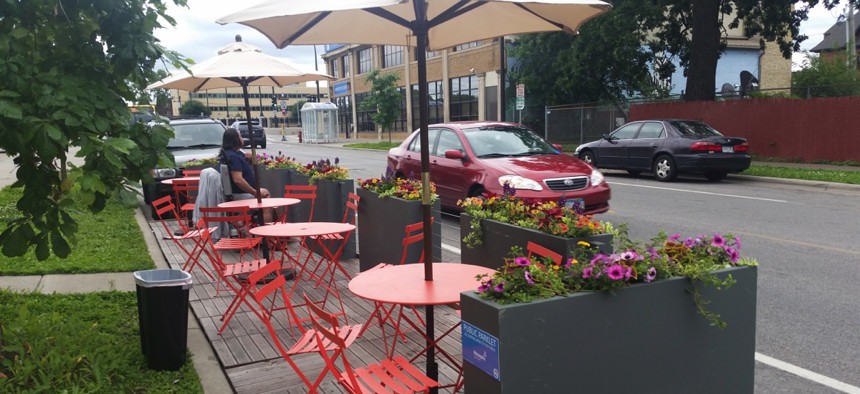Why Parklets Are Working in Minneapolis

Senior resident Steve Neadeau waits for a friend in a parklet in the Elliot Park neighborhood of Minneapolis. Dave Nyczepir / Route Fifty

Connecting state and local government leaders
The sidewalk extensions trade parking for public spaces promoting walking, biking, community and economic development.
MINNEAPOLIS — Samatar Dualeh’s business, Twin Cities Coffee and Deli, is located up the street from a used car lot and a busy, depressed freeway south of downtown. This part of the Elliot Park neighborhood isn’t necessarily what you’d consider a place that naturally fosters walkability.
But in February the Somali immigrant, who opened his shop in 2008, applied for a "parklet" permit to attract more business.
Spanning two parking spaces along the curb along Chicago Avenue South, the parklet serves as a sidewalk extension offering shaded seating encompassed by plantings.
The city expects Dualeh to keep the parklet clean, store its umbrellas at night and water the flowers. Two weeks in and he’s already reaping the benefits. Dualeh’s deli is now a focal point within the neighborhood.
“I like it very much. People are sitting here to take a rest, to eat, and it’s improving the image of the city,” he told Route Fifty this week. “People like it.”
And the city of Minneapolis likes that the five parklets it approved for use through Oct. 31 are getting more residents out of their cars and walking or biking its streets.
Now in its third year, the parklets program permitted three city-sponsored spaces and two backed by a development and other neighborhood stakeholders.
The cost-effective sidewalk extensions liven up streets not only with added seating but other amenities like public art installations and bike parking.
“Biking is usually about how to get people through corridors and walking about how to get people comfortable with a space,” said Matthew Dyrdahl, the city's bicycle and pedestrian coordinator. “Parklets are more about how to create great cities.”
Other current parklet locations are outside Smoke in the Pit BBQ and the Central Area Neighborhood Development Organization (CANDO) in the city’s Powderhorn neighborhood and Angry Catfish Bicycle and Coffee Bar in the Standish neighborhood. Hyde Development sponsored a parklet, hosted in partnership with VÉLO apartments, in the Warehouse District and Calhoun Area Residents Action Group (CARAG) another along with Morrissey’s Irish Pub in the Lyn-Lake District.

Local resident Steve Neadeau sat in the deli’s parklet on Wednesday waiting for a friend to arrive at a nearby light rail station. The Minneapolis native said he's pleased with the city’s efforts to transform mobility.
“Since I’ve been up here, there have been a lot of changes—changes to buildings, changes to parks, bike paths, too,” Neadeau said. “I’d like to see more public involvement.”
Minneapolis is working on that by factoring in parklet criteria like accessibility, property owner support, safety, sightlines, and lack of road work.
Although it might seem like a no-brainer, it’s also important to choose areas where people already want to be—especially walkable commercial nodes.
“People are a great way to attract other people,” Dyrdahl said. “That seems to make for a better place in general.”
Dave Nyczepir is a News Editor at Government Executive’s Route Fifty.

NEXT STORY: Amway Co-Founder’s Grandson Offers $500 for New Mich. Flag; ‘Bizarre’ Property Plan in Provo





